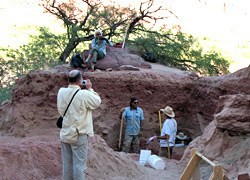Last updated: February 7, 2018
Article
Archeologists excavate two sites along Colorado River

Grand Canyon National Park and Museum of Northern Arizona archeologists excavated two more archeological sites along the Colorado River as part of multi-year project.
A total of nine severely eroded sites will be excavated along the Colorado River corridor. The sites are being excavated because they are too extensively eroded to be preserved in place, making the data recovery efforts the only viable option for park managers.

Ivo's Site
In September 2008, crews excavated an ancestral Puebloan site near Unkar Delta. Unkar Delta is the most extensive habitation site in the Colorado River corridor. In 1967 and 1968, the School of American Research, under the supervision of Douglas Schwarz, excavated 31 of the 52 identified sites at Unkar Delta. Unkar Delta was inhabited during the Formative time period mostly between 1050 and 1150 AD, which corresponds to the ancestral Puebloan, or Anasazi culture.

During their 10-day field session in September 2008, archeologists excavated the six known features at the site, and documented additional features there.




Axehandle Alcove Site
In October 2008, archeological crews excavated the Axehandle Alcove site which is one of the few deposits remaining in Grand Canyon that preserve a long record of Colorado River floods.
The site is located to the inside of a large recirculation eddy and is protected by a large cliff overhang. The sediment at the site records at least 25 different Colorado River floods that occurred during the last 5,000 years. The fine flood-deposited silts are interlayered with coarser debris eroded from the surrounding cliffs. A deep arroyo has cut through this unique deposit eroding cultural material such as charcoal lenses and hearths present in the sediment.

Most of the features are hearths, including one deep slab-lined hearth that may have been used for roasting foodstuffs. Approximately 6,000 lithic artifacts were recovered during excavation, consisting mostly of debitage, or lithic flakes, produced during the construction of stone tools.
Archeologists have provisionally identified six periods of human occupation at the site, ranging from Late Archaic, at about 4,500 years before present, to the Formative period, approximately 900 years ago.

"Because this site lacks structures, it may seem unremarkable to the untrained eye. But the site is very important archeologically because it spans a time period where there are relatively few archeological sites in Grand Canyon and spans the transition from foraging to sedentary life-styles which are dependant on agriculture.
"Additionally, the stratigraphy at the site will allow us to reconstruct the paleoflood history as it relates to human use of the area. Charcoal that we and previous researchers have recovered from the hearths allows us to date the floods and the periods of human use of this site very well.”
Preliminary Findings

While the artifacts recovered during the excavations are still being analyzed in the laboratory, archeologists have arrived at some preliminary conclusion.
Leap said, “One of the things we’ve learned so far is that prehistoric people lived on the same general landscape that we see today along the Colorado River corridor in Grand Canyon.
"For example, the structures at Ivo’s site were buried by debris washed down the hillslopes, whereas other sites were buried by aeolian, or wind-blown, sand. At the Axehandle Alcove site, river flood deposits have preserved cultural material that otherwise would have eroded away.”

Archeologists will excavate three additional sites in April and May 2009 and will continue to learn more about the peoples who called Grand Canyon home in the past.
Grand Canyon National Park Archeological Resources
The River Monitoring Program
generates data regarding the effects of Dam operations on historic properties, identifies ongoing impacts to historic properties within the APE [Area of Potential Effect], and develops and implements remedial measures for treating historic properties subject to damage.
Archeological Excavations at 9 Sites along the Colorado River Corridor
Between 2007 and 2009, the National Park Service, in cooperation with the Museum of Northern Arizona, undertook the first major archeological excavations along the river in Grand Canyon National Park in 40 years.
Archeologists Make Exciting Discoveries Along the Colorado River
In October, 2007, archeologists excavated a habitation site along the Colorado River. The fascinating artifacts they found provide insight into the lives of people who once made the Grand Canyon their home.
Canyon Sketches Vol 03 - May 2008
Archeologists Excavate Kiva by the Colorado River
Archeologists excavated nine archeological sites along the Colorado River because they are being impacted by severe erosion. In April and May 2008, crews discovered a complete kiva during the excavation of one of these sites.
Canyon Sketches Vol 09 - March 2009
Archeologists Excavate Two Sites Along the Colorado River.
In fall 2008, archeologists excavated two archeological sites during a three-year project along the Colorado River corridor in Grand Canyon. One of the excavated sites has evidence of as many as six different human occupations over a time span of 3,500 years.
The Vanishing Treasures Program
Grand Canyon National Park is one of 45 National Park Service areas that participate in the Vanishing Treasures Program. The goal of the Vanishing Treasures program is the conservation of architectural remains through research, documentation, and preservation treatment.
Canyon Sketches Vol 04 – June 2008
Vanishing Treasures Archeologists Stabilize Transept Ruin (North Rim)
In late June 2008, archeologists from Grand Canyon National Park’s Division of Science and Resource Management cleaned and stabilized Transept Ruin, a two-room ancestral Puebloan (Anasazi) ruin on the North Rim.
